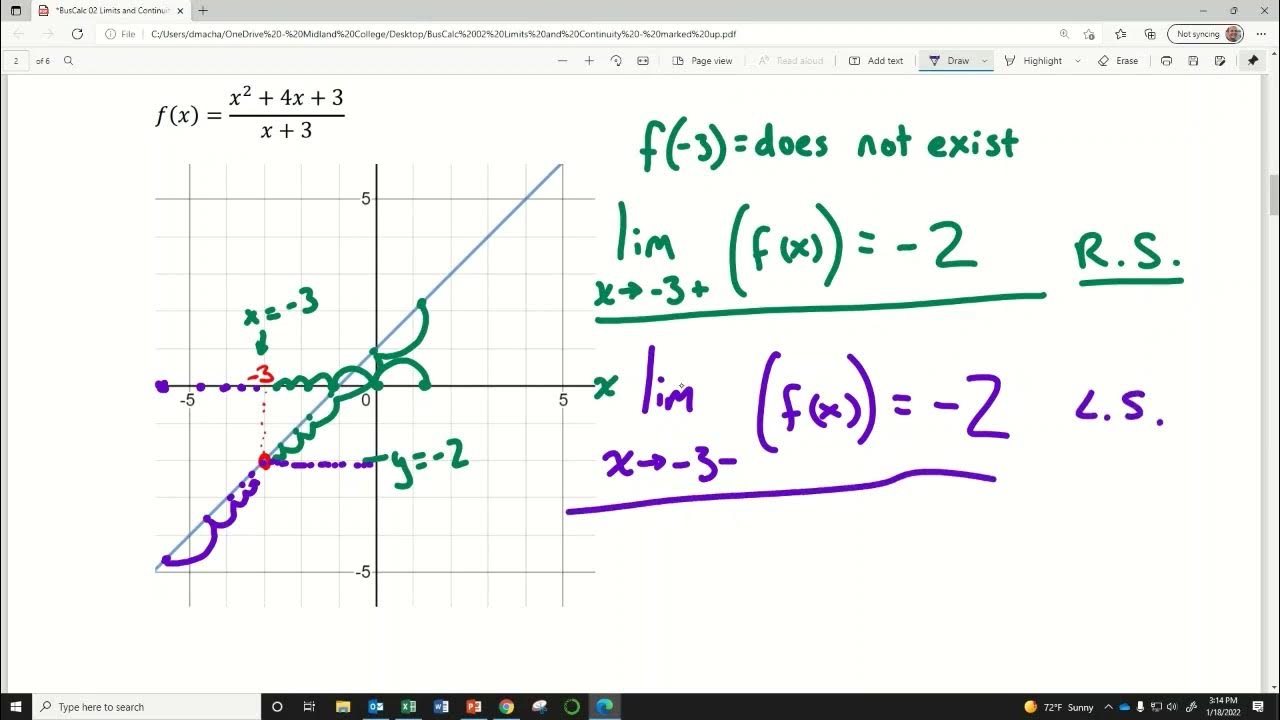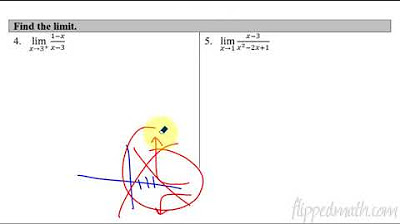Calculus AB/BC – 1.3 Estimating Limit Values from Graphs
TLDRThis calculus lesson delves into one-sided limits, a concept where the function's behavior as it approaches a point from the left or right is analyzed. The instructor explains that unlike two-sided limits, one-sided limits focus on a single direction, using limit notation with a minus sign for the left side and a plus for the right. The lesson includes examples to illustrate how to determine these limits from a graph and emphasizes the importance of understanding when a limit does not exist due to differing left and right approaches. The session concludes with a practical exercise where students must create a graph that satisfies five given conditions, highlighting the application of one-sided limits in problem-solving.
Takeaways
- 📚 The lesson focuses on one-sided limits, which are a type of limit that approaches a given x-value from either the left or the right side.
- 🔍 One-sided limits are denoted by a small minus sign (-) for the left side and a plus sign (+) for the right side in the limit notation.
- 📉 The left-sided limit is the y-value that a function approaches as x approaches a certain number from the left, while the right-sided limit is the y-value as x approaches from the right.
- 🚫 If the left and right one-sided limits do not converge to the same y-value, the overall limit as x approaches that number does not exist.
- 📈 The script provides an example of a graph where the left-sided limit at x=3 is -1 and the right-sided limit is -2, indicating the overall limit does not exist at x=3.
- 📝 The lesson includes a practical exercise where students are to analyze a graph and determine the one-sided limits at specific points.
- 🤔 The importance of understanding the difference between the limit of a function and the actual value of the function at a point is highlighted.
- 📊 A challenging exercise is presented where students must create a graph that satisfies five given conditions, including specific one-sided limits and the behavior of the function between points.
- 📌 The script emphasizes the need to verify that all conditions are met when creating a graph, as it's easy to make mistakes and overlook certain requirements.
- 💡 The lesson concludes with a reminder to check each condition to ensure the graph accurately represents all given information about the function's behavior.
- 🎓 Mastery of one-sided limits is an important concept in calculus, and the lesson aims to help students understand and apply this knowledge.
Q & A
What is the main focus of the lesson in the provided transcript?
-The main focus of the lesson is on one-sided limits in calculus, which are limits approached from either the left or the right side of a given x value.
What is the notation used to represent a limit approached from the left side?
-The notation used to represent a limit approached from the left side is 'lim (x → a⁻)', where 'a' is the x value being approached and the minus sign indicates the left side.
How does the notation for a limit approached from the right side differ from the left side?
-The notation for a limit approached from the right side is 'lim (x → a⁺)', using a plus sign to indicate the right side of the x value 'a'.
What does it mean if the left and right one-sided limits of a function at a certain point are different?
-If the left and right one-sided limits of a function at a certain point are different, it means that the limit as x approaches that point does not exist because the function does not approach the same y-value from both sides.
What is the significance of an open circle on a graph in the context of limits?
-An open circle on a graph signifies that the limit exists as x approaches the point, but the function's value at that exact point is not included in the limit definition.
How does the provided lesson distinguish between the limit at a point and the function's value at that point?
-The lesson distinguishes between the limit at a point and the function's value at that point by noting that the limit is where the function is headed as x approaches a certain value, while the function's value at that point is the actual y-value of the function when x equals that value.
What is the purpose of the practice problems at the end of the lesson?
-The purpose of the practice problems is to allow students to apply their understanding of one-sided limits by analyzing a graph and determining the behavior of the function as x approaches certain values.
What is the condition that must be met for a function to be considered increasing on an interval?
-A function is considered increasing on an interval if, for any two points in that interval, the function's value at the point with the larger x-value is greater than its value at the point with the smaller x-value.
How does the lesson explain the concept of a limit not existing at a certain point?
-The lesson explains that a limit does not exist at a certain point if the left and right one-sided limits do not converge to the same y-value, indicating that the function does not have a well-defined behavior as x approaches that point.
What is the importance of checking each condition when creating a graph that satisfies multiple limit conditions?
-Checking each condition is important to ensure that the graph correctly represents all the given limit behaviors and that there are no contradictions or errors in the graph's construction.
What does the lesson suggest to do if you find an error while checking the conditions for a graph?
-The lesson suggests that if an error is found while checking the conditions, you should go through the conditions again and adjust the graph accordingly to resolve the discrepancy and ensure all conditions are met.
Outlines
📚 Introduction to One-Sided Limits in Calculus
This paragraph introduces the concept of one-sided limits in calculus, which is a more specific type of limit analysis compared to the two-sided limits discussed in a previous lesson. The focus is on how the function's output (Y value) behaves as the input (X value) approaches a certain number, but only from either the left or the right side. The instructor explains the notation for left-sided (lim_{x o 3^-} f(x)) and right-sided (lim_{x o 3^+} f(x)) limits and illustrates the scenario where a limit does not exist if the left and right limits converge to different Y values. The paragraph includes an interactive approach, encouraging students to pause and attempt the examples provided on their own.
📈 Applying One-Sided Limits to Graphs and Practice Problems
The second paragraph delves into applying the concept of one-sided limits to graphical representations and solving practice problems. The instructor guides students through identifying one-sided limits on a graph, demonstrating how to approach a point from the left or right and interpret the Y values accordingly. The paragraph also addresses the scenario where the function's value at a point differs from the limit as X approaches that point. Furthermore, it presents a creative exercise where students must construct a graph that satisfies five given conditions, emphasizing the importance of checking each condition to ensure accuracy. The lesson concludes with a reminder to practice and verify each step for mastery.
Mindmap
Keywords
💡One-sided limits
💡Left-sided limit
💡Right-sided limit
💡Limit notation
💡Non-existent limit
💡Graph
💡Continuous function
💡Open circle
💡Filled-in circle
💡Increasing function
💡Mastery check
Highlights
Introduction to one-sided limits in calculus, contrasting with two-sided limits.
Definition of one-sided limits focusing on the approach from the left or right side of a given x-value.
Explanation of the left-sided limit notation using the '-' exponent to indicate approaching from the left.
Clarification of the right-sided limit notation with the '+' exponent signifying the approach from the right.
Condition where the limit does not exist if left and right-sided limits converge to different y-values.
Demonstration of determining left and right-sided limits using a graph as a visual aid.
Illustration of how to interpret the graph to find the y-values for one-sided limits.
Practice exercise involving identifying one-sided limits on a complex graph.
Instruction on how to approach negative two from the left side on a graph to find the limit.
Method to determine the limit as X approaches one from both sides and its significance.
Explanation of the difference between the limit and the actual value of the function at a point.
Guidance on creating a graph that satisfies five given conditions for a function.
Process of graphing a function with specific limits and values at certain points.
Importance of ensuring the graph reflects the function's increasing nature over a specified interval.
Challenge of interpreting and applying the condition that the left side of a point is higher than the right.
Final review and verification of the graph against all given conditions to ensure accuracy.
Encouragement for students to practice and check their work for understanding one-sided limits.
Transcripts
Browse More Related Video

Calculus - One Sided Limits

BusCalc 02 Limits and Continuity

One-sided limits from graphs | Limits | Differential Calculus | Khan Academy

Calculus AB/BC – 1.14 Infinite Limits and Vertical Asymptotes

Find Limits from Graphs | Calculus 1

Worked example: Continuity at a point | Limits and continuity | AP Calculus AB | Khan Academy
5.0 / 5 (0 votes)
Thanks for rating: